Chapter 23: The Digestive System
0.0(0)
0.0(0)
Card Sorting
1/167
Earn XP
Description and Tags
Study Analytics
Name | Mastery | Learn | Test | Matching | Spaced |
|---|
No study sessions yet.
168 Terms
1
New cards
digestive system
functions to take in food and break it down into nutrient molecules that can be absorbed into the blood stream, ridding the body of anything indigestible that remains
2
New cards
alimentary canal
“GI tract”; continuous muscular tube where food is broken down into fragments (digested) mechanically and chemically, and absorbed
3
New cards
mechanical digestion
physical breakdown of food which includes chewing and swallowing food, mixing food with saliva, and the mixing and churning of food with stomach acid in the stomach
4
New cards
chemical digestion
enzymatic breakdown of food that occurs in the mouth, pharynx, esophagus, stomach, and intestines
5
New cards
accessory digestive organs
teeth, tongue, gallbladder, digestive glands (liver, salivary, and pancreas glands) aid the digestive organs in the breakdown of food physically or by producing necessary enzymes
6
New cards
ingestion
the taking in of food
7
New cards
propulsion
the movement of food, which includes swallowing and peristalsis
8
New cards
peristalsis
between meals; coordinated contractions that force food down the alimentary canal (major means of propulsion); contraction/relaxation coupling of rest and digest process
9
New cards
segmentation
local, coordinated constriction in the intestines to mix chyme with digestive juices
10
New cards
digestion
a series of catabolic steps where enzymes break down complex molecules (macromolecules) into monomers that are small enough for absorption
11
New cards
defacation
the passing of undigested materials as feces
12
New cards
peritoneum
serous membrane of the abdominal cavity (visceral and parietal)
13
New cards
visceral peritoneum
the part of the serous membrane of the abdominal cavity that exists on the surface of most digestive organs
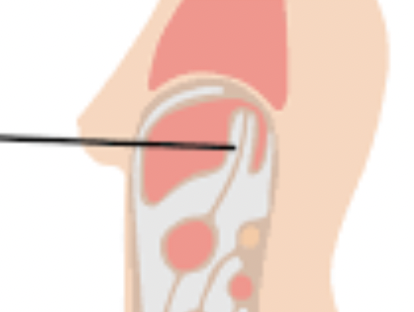
14
New cards
parietal peritoneum
the part of the serous membrane of the abdominal cavity that lines the cavity wall
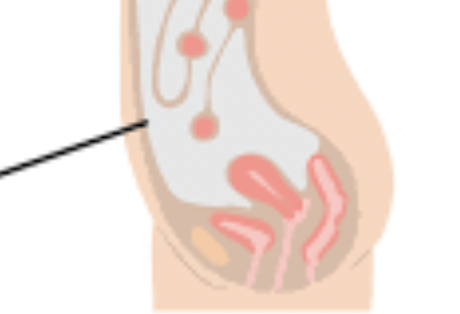
15
New cards
peritoneal cavity
prevents friction between the visceral and parietal peritonea
16
New cards
mesentery
double-layered peritoneum that provides routes for blood vessels to innervate the digestive system; stores fat and secures digestive organs in place
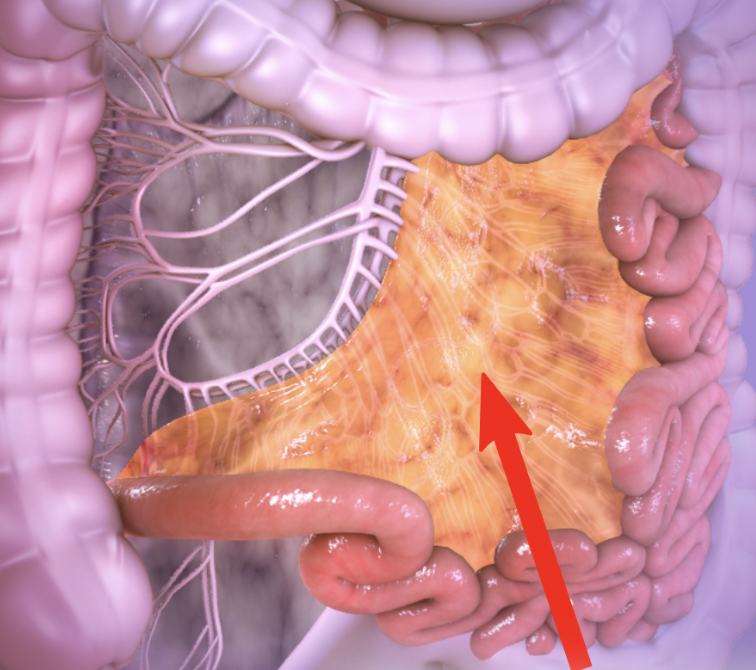
17
New cards
intraperitoneal organs
organs inside the peritoneum
18
New cards
retroperitoneal organs
organs outside the peritoneum
19
New cards
peritonitis
inflammation of the peritoneum that can be caused by abdominal wounds, chemical damage to the abdominal wall (ulcers), or appendicitis that results in pain due to the dense innervation of the digestive system and chemoreceptors
20
New cards
mucosa
lines the lumen of the alimentary canal to secrete mucus, digestive enzymes, and some hormones, absorbs the end-products of digestion, and can help to protect against infections and diseases
21
New cards
epithelium
secretes mucus to protect the alimentary canal from strong digestive enzymes
22
New cards
lamina propria
the primary capillary location of the alimentary canal that contains lymphoid follicles (part of mucosa)
23
New cards
muscular mucosa
(“muscularis”) smooth muscle of the alimentary canal that produces localized movements of the mucosa
24
New cards
submucosa
layer of the alimentary canal that contains blood, lymphatic vessels, and lots of elastic fibers to allow the canal to recoil and retain its shape after stretch
25
New cards
muscularis external
areas and prevent layer of the alimentary canal that is thick in places with sphincters to close food from moving from one layer to the next

26
New cards
serosa
the outermost layer of the alimentary canal that is continuous with the visceral peritoneum; single layer of simple squamous epithelium
27
New cards
eccentric nervous system
innervates the GI tract with more than the spinal cord
28
New cards
submucosal nerve plexus
helps regulate glands and smooth muscle with the mucosa of the digestive system
29
New cards
myenteric nerve plexus
helps control GI tract motility
30
New cards
short reflexes
mediated by the enteric nervous system and responds to stimuli within the GI tract (intrinsic)
31
New cards
long reflexes
external factors (smell, taste, etc. - extrinsic) are affected by the sympathetic and parasympathetic nervous system

32
New cards
regulation
provoked by mechanical and chemical digestion stimulation; receptors detect changes in osmolarity, pH, bi-products of digestion for reabsorption, etc.
33
New cards
effectors
smooth muscle and glands whose reflexes are stimulated by some receptors to move contents of the lumen to specific areas and can reflexively inhibit or release enzymes and/or hormone
34
New cards
mouth
“buccal/oral cavity”, made up of lips, the palates, tongue, and cheeks
35
New cards
lips
(labia) fleshy reticuoral vestilaris muscles that anteriorly bind the mouth
36
New cards
palate
superiorly binds the mouth; hard and soft
37
New cards
soft palate
helps to close off the nasopharynx during swallowing and can contribute to snoring
38
New cards
tongue
complex skeletal muscle that posteriorly binds the mouth and positions/molds food, mixes food and saliva, and is key for swallowing, taste, and speech
39
New cards
oral vestibule
the area between the teeth and the lips
40
New cards
labial frenulum
the sharp, small piece of tissue between the teeth and the lips; superior and inferior
41
New cards
linguil frenulum
connects the tongue to the base of the mouth
42
New cards
filiform papillae
bumps on the tongue that contribute to its roughness but do not contain any tastebuds
43
New cards
fungiform papillae
mushroom-shaped taste buds that are scattered over the tongue and are highly vascularized, leading to the tongue’s pinkish hue
44
New cards
vallate papillae
taste buds that create a V-shape on the back of the tongue
45
New cards
foliate papillae
taste buds located on the lateral aspects of the tongue
46
New cards
salivary glands
produce saliva and are controlled by chemo- and mechano-receptors that detect the presence of food and stretch of stimuli to notify the parasympathetic nervous system; parotid, submandibular, and sublinguil
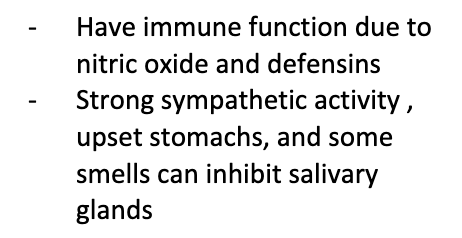
47
New cards
saliva
primarily water, slightly acidic (pH of 6.8), with lots of electrolytes and digestive enzymes (linguil and salivary amylase), as well as proteins and wastes; helps to cleans the mouth, chemically dissolves food creating “tastes”, moistens foods, and is where starch breakdown begins (with salivary amylase)
48
New cards
xerostomia
“dry mouth”; a lack of saliva that is caused by THC use, HIV/AIDS, and certain medications and can lead to dental carries and tooth decay
49
New cards
teeth
dentitions; key starters of the mechanical digestive process; shape-determines-funuction
50
New cards
incisors
teeth that are chisel-shaped for cutting (4 upper and 2 lower)
51
New cards
canines
teeth that are pointy and fang-like for piercing and tearing food (2 upper and 2 lower)
52
New cards
premolars
teeth also known as “bicuspids”
53
New cards
molars
large teeth for grinding and crushing; key for mechanical digestion of food in oral cavity (4 upper and 4 lower)
54
New cards
crown
the exposed part of a tooth (above the gums) that is the hardest substance in the body
55
New cards
enamel
a heavily mineralized substance made of calcium that makes up a layer on the crown of teeth
56
New cards
root
the part of the tooth under the gums; some teeth have 1, but molars have 2, 3, or 1 extra-large one
57
New cards
cement
holds teeth in place with dental ligaments that surround the root
58
New cards
impacted teeth
teeth that are stuck in the jaw bone that can cause pain and/or structural damage
59
New cards
dental carries
“cavities”; where bacteria wears away enamel
60
New cards
gingivitis
inflammation of the gums that occurs when plaque builds up and calcifies into tartar, disrupting the boundary between teeth and gums, leading to inflammation and bleeding
61
New cards
peridontitis
bad gingivitis that leads to tooth decay
62
New cards
pharynx and esophagus
(oropharynx, laryngopharynx, and esophagus) passage for food, air, and fluids that is made up of stratified squamous epithelium to resist stress from stretch and abrasions with mucus-producing cells to coat the tube for protection
63
New cards
esophagus
organ whose main function is the movement of food (peristalsis); no digestion occurs here
64
New cards
gastroesophageal sphincter
esophagus-stomach junction that surrounds the cardio orifice to keep it closed when not swallowing food to prevent acid from escaping the stomach (controls what enters the stomach)
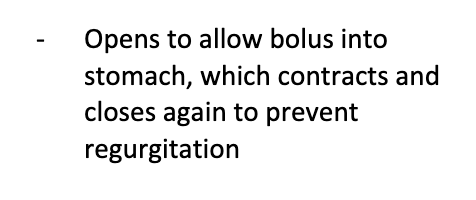
65
New cards
mucus cells
protect bodily tissues from stomach acid
66
New cards
heartburn
“acid reflux”; when the sphincter opens due to damage or it malfunctions, allowing acid to escape from the stomach, leading to burning sensations
67
New cards
deglutination
swallowing; begins with the voluntary contraction of the tongue to force food bolus from the mouth to the oropharynx
68
New cards
bolus
a ball of food and saliva
69
New cards
pharyngoesophageal phase
when the tongue blocks off the mouth to prevent back flow and peristalsis occurs, but no digestion
70
New cards
stomach
extremely expansive tank for food storage where chemical breakdown begins
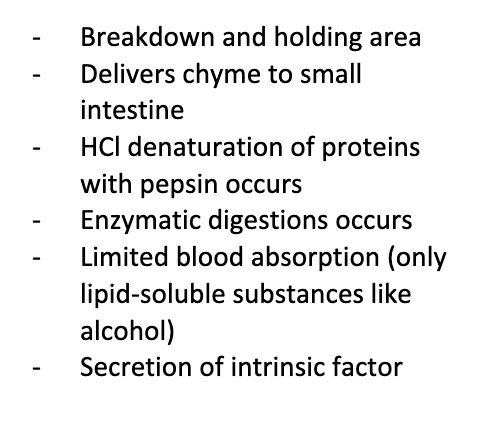
71
New cards
chyme
paste-like substance that food bolus is transformed into from churning aspect of the stomach
72
New cards
cardia
surrounds the cardio orifice of the stomach
73
New cards
fundus
dome of the stomach that sits just inferior to the diaphragm
74
New cards
pyloric sphincter
separates the stomach from the duodenum to control what leaves the stomach
75
New cards
greater omentum
(greater curvature) helps anchor the spleen, stomach, and pancreas to the abdominal wall and contains fat-deposits and lymph nodes
76
New cards
modified muscularis externa
circulate, longitudinal, oblique layers of the stomach that allow three different directions of contractions, leading to the churning aspect and mixing of stomach acids and chyme
77
New cards
pummelling
mixing that occurs due to the churning of the stomach, packing the chyme into the small intestine
78
New cards
modified mucosa
made of simple columnar epithelial cells and mucus-producing cells that produce about 3 L a day of double-layered secretions for protection (alkaline and bicarbonate buffer)
79
New cards
gastric pits
lead into gastric glands which produce gastric juice
80
New cards
secretory cells
rapidly dividing cells that completely regenerate every 3 to 6 days; mucus neck cells, parietal cells, chief cells, enteroendocrine cells, and the mucosal barrier
81
New cards
mucus neck cells
secrete mucus
82
New cards
parietal cells
secrete HC (low pH) to denature proteins, break down plant cell walls, kill bacteria, and help to secrete intrinsic factor

83
New cards
intrinsic factor
glycoprotein that helps absorb vitamin B12
84
New cards
pepsinogen
chief cells produce this inactive form of pepsin, which is activated by HCl
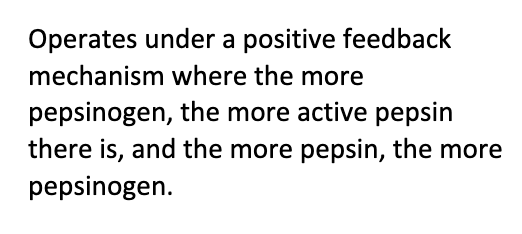
85
New cards
chief cells
secrete pepsinogen and lipases (lipid digestive enzymes)
86
New cards
enteroendocrine cells
secrete chemical messengers into surrounding tunics of the stomach (lamina propria); some act like paracrines, others produce serotonin, histamine, gastrin, and somatotropin
87
New cards
mucosal barrier
part of bicarbonate mucus layer created by tight junctions between epithelial cells that prevent caustic secretions from damaging tissues
88
New cards
stimulation of stomach
causes pH levels to rise, creating more gastrin, so more HCL is released; cephalic/reflex phase, gastric phase, and G cells
89
New cards
cephalic/reflex phase
a conditioned, stimulating response to seeing/thinking/smelling/tasting food that directly leads into the gastric phase
90
New cards
gastric phase
stretch receptors are primed so that stretch stimulates telling the brain how full someone is
91
New cards
G cells
secrete gastrin for the stimulation of HCl release from parietal cells, causing enteroendocrine cells to release histamine
92
New cards
distinction of duodenum
stretch and expansion from over-filling tell the stomach to reduce gastric secretions to slow down chemical digestion
93
New cards
HCl formation
parietal cells pump hydrogen from the breakdown of carbonic acid into the lumen of the stomach through the movement of a proton pump (stopping the movement of hydrogen ions)
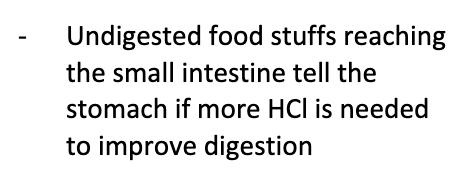
94
New cards
stomach filling
operates according to pressure with reception relaxation and gastric accommodation

95
New cards
reception relaxation
reflex mediated by the brain stem when swallowing food, telling the stomach to relax and not contract
96
New cards
gastric accommodation
“pliability”; the stomach’s innate ability to stretch and accommodate more food
97
New cards
peristaltic wave
gastric contractile activity that occurs 3 times every minute and propels food from one location towards the pyloric sphincter along with grinding and pummeling contractions

98
New cards
liver
the largest gland in the body (secondary digestive organ) that has different ligaments to separate its 4 lobes whose main function is the production of bile; regenerative

99
New cards
bile ducts
a combination of ducts in the liver that produce bile for fat breakdown
100
New cards
hepatocytes
liver cells that filter and process nutrient rich foods